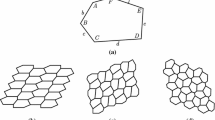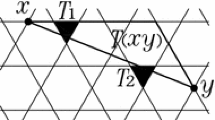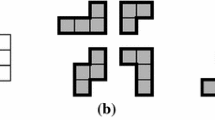Abstract
In previous papers, the cases in which there is a possibility that a convex pentagon generates an edge-to-edge tiling were sorted, and the remaining 42 cases in which there is uncertainty about whether a convex pentagon can generate an edge-to-edge tiling were shown. In this paper, the latter 42 cases are investigated using a computer. As a result, we find that convex pentagons that can generate edge-to-edge monohedral tiling of the plane can be sorted into eight types.






Similar content being viewed by others
Notes
DDE-2 represents the sub-cases of the tentative 3-valent node \(\{D,D,E\}\). When convex pentagons are assembled around a tentative 3-valent node, there are eight possible ways to assemble the three pentagons. As a result, some sub-cases arise for edge fitting around the 3-valent node. For example, as shown in Fig. 2, \(\{D,D,E\}\) has two sub-cases, DDE-1 and DDE-2. Notice that the equations following the colons for each label in the figure represent the conditions on edge-lengths. The convex pentagon of this example can use only DDE-2 (the two arrangement way of DDE-2) from the edge conditions. Refer to Section 4 in [8] for details.
References
Bagina, O.: Tiling the plane with congruent equilateral convex pentagons. J. Comb. Theory Ser. A 105, 221–232 (2004)
Bagina, O.: Tilings of the plane with convex pentagons (in Russian). Vestnik KemGU 4(48), 63–73 (2011)
Gardner, M.: On tessellating the plane with convex polygon tiles. Sci. Am. 233(1), 112–117 (1975)
Grünbaum, B., Shephard, G.C.: Tilings and Patterns, pp. 15–35 (chapter 1), pp. 113–157 (chapter 3), pp. 471–487, pp. 492–497, and pp. 517–518 (chapter 9). W. H. Freeman and Company, New York (1987)
Hallard, T.C., Kenneth, J.F., Richard, K.G.: Unsolved Problems in Geometry, pp. 79–80, pp. 95–96 (C14). Springer, New York (1991)
Kershner, R.B.: On paving the plane. Am. Math. Mon. 75, 839–844 (1968)
Schattschneider, D.: Tiling the plane with congruent pentagons. Math. Mag. 51(1978), 29–44 (1978)
Sugimoto, T.: Convex pentagons for edge-to-edge tiling, I. FORMA 29, 93–103 (2012)
Sugimoto, T.: Convex pentagons for edge-to-edge tiling and convex polygons for aperiodic tiling (in Japanese), Ouyou suugaku goudou kenkyuu syuukai houkokusyuu (Proceeding of Applied Mathematics Joint Workshop), pp. 126–131 (2012)
Sugimoto, T.: Convex pentagons for edge-to-edge tiling, II. Graphs Comb. 31, 281–298 (2015). doi:10.1007/s00373-013-1385-x
Sugimoto, T., Ogawa, T.: Properties of tilings by convex pentagons. FORMA 21, 113–128 (2006)
Wells, D.: The Penguin Dictionary of Curious and Interesting Geometry, pp. 177–179. Penguin Books, London (1991)
Acknowledgments
The authors would like to give heartful thanks to Emeritus Professor Hiroshi Maehara, University of the Ryukyus, and Professor Shigeki Akiyama, University of Tsukuba, whose enormous support and insightful comments were invaluable. The authors would also like to thank Associate Professor Genta Ueno, The Institute of Statistical Mathematics, for a critical reading of the manuscript. The comments of the referees also helped to clarify the article.
Author information
Authors and Affiliations
Corresponding author
Appendix A.1
Appendix A.1
Let \(T_{x}\) be a set of convex pentagonal tiles that belongs to a type x for x = 1, 2, 4, 5, 6, 7, 8, 9. Figure 7 shows examples of the Venn diagram of \(T_{x}\). Figure 8 shows examples of the convex pentagonal tiles that are contained in each intersection of Fig. 7.
Convex pentagonal tiles that are contained in each intersection of Fig. 7. Representative tilings of type 2 by convex pentagonal tiles of a, i, j, m, and o are always non-edge-to-edge. Representative tilings of type 1 by convex pentagonal tiles of c, e, f, and p are always non-edge-to-edge
Rights and permissions
About this article
Cite this article
Sugimoto, T. Convex Pentagons for Edge-to-Edge Tiling, III. Graphs and Combinatorics 32, 785–799 (2016). https://doi.org/10.1007/s00373-015-1599-1
Received:
Revised:
Published:
Issue Date:
DOI: https://doi.org/10.1007/s00373-015-1599-1






